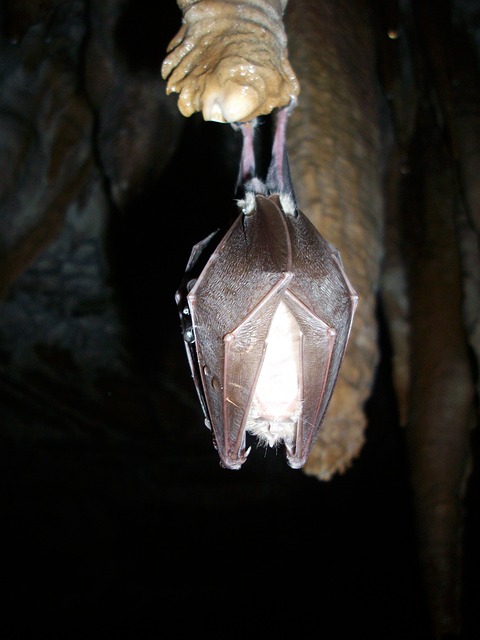Bats, ecosystem engineers, play crucial roles in pollination, pest control, and seed dispersal. Commercial bat removal practices can disrupt ecological balance due to bats' importance in insect management. Adopting humane, eco-friendly solutions like exclusionary netting, ultrasonic devices, and scent repellents allows for safe coexistence with these adaptable creatures while mitigating the need for toxic chemicals and aggressive tactics. Proactive measures such as sealing entry points and installing bat houses, coupled with education, foster a harmonious relationship between humans and bats, ensuring long-term coexistence with minimal impact on both parties.
Discover safe and sustainable methods for managing bats on your property, especially in urban areas. Bats play a vital role in our ecosystems, so understanding their behavior is crucial for effective, eco-friendly control. This article explores traditional and modern approaches to bat removal, focusing on commercial settings. Learn about best practices for humane relocation and long-term solutions to prevent future infestations, ensuring a harmonious balance between humans and these nocturnal creatures.
Keywords: commercial bat removal, bat ecology, sustainable control methods.
Understanding Bat Ecology and Their Role in Ecosystems
Bats play a vital role in ecosystems, serving as important pollinators, insect predators, and seed dispersers. They contribute significantly to controlling insect populations and maintaining ecological balance. In many regions, commercial bat removal practices have emerged, often driven by concerns over disease transmission or structural damage. However, it’s crucial to recognize the long-term consequences of removing bats, which can disrupt natural pest control mechanisms and impact ecosystem health.
Understanding bat ecology is essential for implementing safe and eco-friendly methods of bat control. Bats are highly adaptable and play diverse roles in different habitats, from forests to urban areas. By considering their ecological significance, we can develop strategies that promote coexistence with these fascinating creatures while addressing legitimate concerns related to commercial bat removal.
Traditional vs. Eco-Friendly Bat Control Methods
In the realm of bat control, traditional methods often involve toxic chemicals and aggressive tactics, raising concerns for both human health and environmental sustainability. These conventional practices, while effective in short-term pest management, can lead to long-lasting ecological imbalances and pose risks to non-target species. As a result, there’s a growing emphasis on adopting eco-friendly alternatives for commercial bat removal.
Eco-conscious approaches prioritize the safety of both humans and bats, aiming to humanely repel or relocate these creatures without causing harm. Techniques such as exclusionary netting, ultrasonic devices, and scent repellents are gaining popularity among professionals. These methods not only provide effective long-term solutions but also ensure the well-being of bats, fostering a harmonious coexistence with these beneficial insects in our ecosystems.
Best Practices for Commercial Bat Removal
When it comes to commercial bat removal, safety and sustainability are paramount. Professionals should always prioritize non-lethal methods to ensure the well-being of these important wildlife species while addressing infestations. This often involves carefully planning and executing exclusion strategies, sealing entry points, and using one-way doors to guide bats out without allowing reentry.
Effective commercial bat removal also requires meticulous record-keeping, adherence to local regulations, and communication with stakeholders like building managers and tenants. By following best practices, experts can humanely resolve bat issues, mitigate health risks associated with guano and disease transmission, and maintain a balance between business operations and environmental conservation.
Preventive Measures and Long-Term Solutions for Bat Management
In the realm of commercial bat removal, preventive measures and long-term solutions are paramount to ensuring a harmonious coexistence with these nocturnal creatures. One of the primary strategies involves sealing off potential entry points into buildings and structures. This includes meticulous inspection and repair of gaps, cracks, and openings, especially in areas prone to moisture intrusion, as bats are attracted to such habitats. Regular maintenance and upkeep can significantly deter bat infestations before they occur.
Additionally, implementing eco-friendly practices for bat management is both sustainable and effective. Installing bat houses or providing alternative roosting sites away from human dwellings encourages bats to reside in designated areas, reducing the need for commercial bat removal services. Education and awareness campaigns can also play a pivotal role, informing residents about the ecological significance of bats and promoting non-lethal methods for their control. These measures not only address immediate concerns but also foster a long-term, respectful relationship between humans and these fascinating flying mammals.
In conclusion, understanding bat ecology and adopting safe, eco-friendly methods for bat control is essential. By preferring these approaches over traditional techniques, we can effectively manage bat populations while preserving their vital role in ecosystems. For commercial bat removal, best practices include professional, comprehensive strategies that ensure the safety of both humans and bats. Preventive measures and long-term solutions, such as sealing entry points and maintaining habitats, are key to mitigating bat-related issues sustainably.
